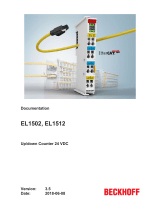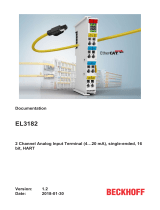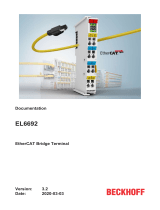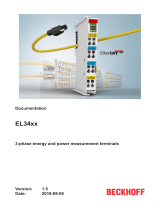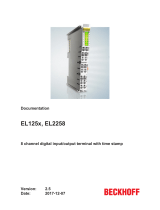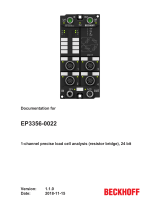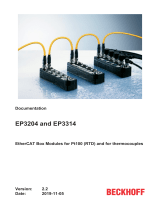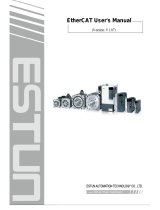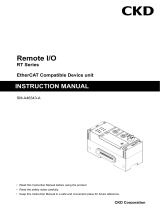Page is loading ...

Documentation
EL28xx-xxxx
Digital HD Output Terminals
2.2
2019-01-03
Version:
Date:


Table of contents
EL28xx-xxxx 3Version: 2.2
Table of contents
1 Foreword ....................................................................................................................................................5
1.1 Product overview: EtherCAT digital HD output terminals ..................................................................5
1.2 Notes on the documentation..............................................................................................................5
1.3 Safety instructions .............................................................................................................................7
1.4 Documentation issue status ..............................................................................................................8
1.5 Version identification of EtherCAT devices .......................................................................................8
1.6 Non-reactive Bus Terminals ............................................................................................................13
2 Product overview.....................................................................................................................................17
2.1 EL2808 ............................................................................................................................................17
2.1.1 Introduction ...................................................................................................................... 17
2.1.2 Technical data ................................................................................................................. 18
2.1.3 Pin assignment and LEDs ............................................................................................... 19
2.2 EL2828 ............................................................................................................................................20
2.2.1 Introduction ...................................................................................................................... 20
2.2.2 Technical data ................................................................................................................. 21
2.2.3 Pin assignment and LEDs ............................................................................................... 22
2.3 EL2809, EL2889 .............................................................................................................................23
2.3.1 Introduction ...................................................................................................................... 23
2.3.2 Technical data ................................................................................................................. 24
2.3.3 Pin assignment and LEDs ............................................................................................... 25
2.4 EL2872, EL2872-0010.....................................................................................................................26
2.4.1 Introduction ...................................................................................................................... 26
2.4.2 Technical data ................................................................................................................. 27
2.4.3 Pin assignment and LEDs ............................................................................................... 28
2.5 EL2819 ............................................................................................................................................29
2.5.1 Introduction ...................................................................................................................... 29
2.5.2 Technical data ................................................................................................................. 30
2.5.3 Pin assignment and LEDs ............................................................................................... 31
2.5.4 Overload protection ......................................................................................................... 32
2.5.5 Operating modes and settings......................................................................................... 33
2.5.6 Object description and parameterization ......................................................................... 40
3 Basics communication ...........................................................................................................................52
3.1 EtherCAT basics..............................................................................................................................52
3.2 EtherCAT cabling – wire-bound.......................................................................................................52
3.3 General notes for setting the watchdog...........................................................................................53
3.4 EtherCAT State Machine.................................................................................................................55
3.5 CoE Interface...................................................................................................................................57
3.6 Distributed Clock .............................................................................................................................62
4 Mounting and wiring................................................................................................................................63
4.1 Instructions for ESD protection........................................................................................................63
4.2 Installation on mounting rails ...........................................................................................................63
4.3 Installation instructions for enhanced mechanical load capacity .....................................................67
4.4 Connection ......................................................................................................................................67

Table of contents
EL28xx-xxxx4 Version: 2.2
4.4.1 Connection system .......................................................................................................... 67
4.4.2 Wiring............................................................................................................................... 69
4.4.3 Shielding .......................................................................................................................... 70
4.5 Installation positions ........................................................................................................................70
4.6 Positioning of passive Terminals .....................................................................................................73
4.7 UL notice .........................................................................................................................................73
4.8 ATEX - Special conditions (standard temperature range) ...............................................................75
4.9 ATEX - Special conditions (extended temperature range) ..............................................................76
4.10 ATEX Documentation ......................................................................................................................77
5 Commissioning........................................................................................................................................78
5.1 TwinCAT Quick Start .......................................................................................................................78
5.1.1 TwinCAT2 ....................................................................................................................... 80
5.1.2 TwinCAT 3 ....................................................................................................................... 90
5.2 TwinCAT Development Environment ............................................................................................102
5.2.1 Installation of the TwinCAT real-time driver................................................................... 102
5.2.2 Notes regarding ESI device description......................................................................... 108
5.2.3 TwinCAT ESI Updater ................................................................................................... 112
5.2.4 Distinction between Online and Offline.......................................................................... 112
5.2.5 OFFLINE configuration creation .................................................................................... 113
5.2.6 ONLINE configuration creation ...................................................................................... 118
5.2.7 EtherCAT subscriber configuration................................................................................ 126
5.3 General Notes - EtherCAT Slave Application................................................................................135
6 Appendix ................................................................................................................................................143
6.1 EtherCAT AL Status Codes...........................................................................................................143
6.2 Firmware compatibility...................................................................................................................143
6.3 Firmware Update EL/ES/EM/EPxxxx ............................................................................................143
6.3.1 Device description ESI file/XML..................................................................................... 144
6.3.2 Firmware explanation .................................................................................................... 147
6.3.3 Updating controller firmware *.efw................................................................................. 148
6.3.4 FPGA firmware *.rbf....................................................................................................... 150
6.3.5 Simultaneous updating of several EtherCAT devices.................................................... 154
6.4 Firmware compatibility - passive terminals....................................................................................155
6.5 Restoring the delivery state ...........................................................................................................155
6.6 Support and Service ......................................................................................................................156

Foreword
EL28xx-xxxx 5Version: 2.2
1 Foreword
1.1 Product overview: EtherCAT digital HD output
terminals
EL2808 [}17]
8 digital outputs; 24V
DC
, 0.5A
EL2828 [}20]
8 digital outputs; 24V
DC
, 2A
EL2809 [}23]
16 digital outputs; 24V
DC
, 0.5A
EL2889 [}23]
16 digital outputs; 24V
DC
, 0.5A, switching to negative potential
EL2872 [}26]
16 digital outputs; 24V
DC
, 0.5A; ribbon cable connection
EL2872-0010 [}26]
16 digital outputs; 24V
DC
, 0.5A; ribbon cable connection, negative switching
EL2819 [}29]
16 digital outputs; 24V
DC
, 0.5A, with diagnostics
1.2 Notes on the documentation
Intended audience
This description is only intended for the use of trained specialists in control and automation engineering who
are familiar with the applicable national standards.
It is essential that the documentation and the following notes and explanations are followed when installing
and commissioning these components.
It is the duty of the technical personnel to use the documentation published at the respective time of each
installation and commissioning.
The responsible staff must ensure that the application or use of the products described satisfy all the
requirements for safety, including all the relevant laws, regulations, guidelines and standards.
Disclaimer
The documentation has been prepared with care. The products described are, however, constantly under
development.
We reserve the right to revise and change the documentation at any time and without prior announcement.
No claims for the modification of products that have already been supplied may be made on the basis of the
data, diagrams and descriptions in this documentation.
Trademarks
Beckhoff
®
, TwinCAT
®
, EtherCAT
®
, EtherCATP
®
, SafetyoverEtherCAT
®
, TwinSAFE
®
, XFC
®
and XTS
®
are
registered trademarks of and licensed by Beckhoff Automation GmbH.
Other designations used in this publication may be trademarks whose use by third parties for their own
purposes could violate the rights of the owners.
Patent Pending
The EtherCAT Technology is covered, including but not limited to the following patent applications and
patents: EP1590927, EP1789857, DE102004044764, DE102007017835 with corresponding applications or
registrations in various other countries.
The TwinCAT Technology is covered, including but not limited to the following patent applications and
patents: EP0851348, US6167425 with corresponding applications or registrations in various other countries.
EtherCAT
®
is registered trademark and patented technology, licensed by Beckhoff Automation GmbH,
Germany.

Foreword
EL28xx-xxxx6 Version: 2.2
Copyright
© Beckhoff Automation GmbH & Co. KG, Germany.
The reproduction, distribution and utilization of this document as well as the communication of its contents to
others without express authorization are prohibited.
Offenders will be held liable for the payment of damages. All rights reserved in the event of the grant of a
patent, utility model or design.

Foreword
EL28xx-xxxx 7Version: 2.2
1.3 Safety instructions
Safety regulations
Please note the following safety instructions and explanations!
Product-specific safety instructions can be found on following pages or in the areas mounting, wiring,
commissioning etc.
Exclusion of liability
All the components are supplied in particular hardware and software configurations appropriate for the
application. Modifications to hardware or software configurations other than those described in the
documentation are not permitted, and nullify the liability of Beckhoff Automation GmbH & Co. KG.
Personnel qualification
This description is only intended for trained specialists in control, automation and drive engineering who are
familiar with the applicable national standards.
Description of instructions
In this documentation the following instructions are used.
These instructions must be read carefully and followed without fail!
DANGER
Serious risk of injury!
Failure to follow this safety instruction directly endangers the life and health of persons.
WARNING
Risk of injury!
Failure to follow this safety instruction endangers the life and health of persons.
CAUTION
Personal injuries!
Failure to follow this safety instruction can lead to injuries to persons.
NOTE
Damage to environment/equipment or data loss
Failure to follow this instruction can lead to environmental damage, equipment damage or data loss.
Tip or pointer
This symbol indicates information that contributes to better understanding.

Foreword
EL28xx-xxxx8 Version: 2.2
1.4 Documentation issue status
Version Comment
2.2 • Update chapter "Notes on the documentation"
• Amendments in chapter "Non-reactive Bus Terminals"
• Update chapter "Technical data"
• Update EL2819 / chapter "Basic function principles" -> "Overload protection"
• Addenda chapter "Instructions for ESD protection"
• Chapter "ATEX - Special conditions" replaced with chapter "ATEX - Special conditions
(extended temperature range)"
• Addenda chapter "ATEX - Special conditions (extended temperature range)"
• Addenda chapter "TwinCAT Quickstart"
• Update chapter "TwinCAT 2.1x" -> "TwinCAT Development Environment"
• Update structure
• Update revision status
2.1 • Chapter “Non-reactive Bus Terminals” added
• Update structure
2.0 • EL2819 added
• First publication in PDF format
1.8 • “Technical data” chapter updated
• chapter “Assembly instructions with increased mechanical load capacity” supplemented
• Structural update
1.7 • Structural update
• “Technical data” chapter updated: notes on ET
1.6 • “Technical data” chapter updated
1.5 • EL2872-0010 added
• “Technical data” chapter updated
1.4 • EL2828 added
1.3 • Additions to technical data
1.2 • Additions to technical notes
1.1 • EL2872, EL2889 added
• Additions to technical notes
1.0 • First publication
0.1 • Provisional documentation for EL28xx
1.5 Version identification of EtherCAT devices
Designation
A Beckhoff EtherCAT device has a 14-digit designation, made up of
• family key
• type
• version
• revision

Foreword
EL28xx-xxxx 9Version: 2.2
Example Family Type Version Revision
EL3314-0000-0016 EL terminal
(12 mm, non-
pluggable connection
level)
3314 (4-channel thermocouple
terminal)
0000 (basic type) 0016
ES3602-0010-0017 ES terminal
(12 mm, pluggable
connection level)
3602 (2-channel voltage
measurement)
0010 (high-
precision version)
0017
CU2008-0000-0000 CU device 2008 (8-port fast ethernet switch) 0000 (basic type) 0000
Notes
• The elements mentioned above result in the technical designation. EL3314-0000-0016 is used in the
example below.
• EL3314-0000 is the order identifier, in the case of “-0000” usually abbreviated to EL3314. “-0016” is the
EtherCAT revision.
• The order identifier is made up of
- family key (EL, EP, CU, ES, KL, CX, etc.)
- type (3314)
- version (-0000)
• The revision -0016 shows the technical progress, such as the extension of features with regard to the
EtherCAT communication, and is managed by Beckhoff.
In principle, a device with a higher revision can replace a device with a lower revision, unless specified
otherwise, e.g. in the documentation.
Associated and synonymous with each revision there is usually a description (ESI, EtherCAT Slave
Information) in the form of an XML file, which is available for download from the Beckhoff web site.
From 2014/01 the revision is shown on the outside of the IP20 terminals, see Fig. “EL5021 EL terminal,
standard IP20 IO device with batch number and revision ID (since 2014/01)”.
• The type, version and revision are read as decimal numbers, even if they are technically saved in
hexadecimal.
Identification number
Beckhoff EtherCAT devices from the different lines have different kinds of identification numbers:
Production lot/batch number/serial number/date code/D number
The serial number for Beckhoff IO devices is usually the 8-digit number printed on the device or on a sticker.
The serial number indicates the configuration in delivery state and therefore refers to a whole production
batch, without distinguishing the individual modules of a batch.
Structure of the serial number: KKYYFFHH
KK - week of production (CW, calendar week)
YY - year of production
FF - firmware version
HH - hardware version
Example with
Ser. no.: 12063A02: 12 - production week 12 06 - production year 2006 3A - firmware version 3A 02 -
hardware version 02
Exceptions can occur in the IP67 area, where the following syntax can be used (see respective device
documentation):
Syntax: D ww yy x y z u
D - prefix designation
ww - calendar week
yy - year
x - firmware version of the bus PCB

Foreword
EL28xx-xxxx10 Version: 2.2
y - hardware version of the bus PCB
z - firmware version of the I/O PCB
u - hardware version of the I/O PCB
Example: D.22081501 calendar week 22 of the year 2008 firmware version of bus PCB: 1 hardware version
of bus PCB: 5 firmware version of I/O PCB: 0 (no firmware necessary for this PCB) hardware version of I/O
PCB: 1
Unique serial number/ID, ID number
In addition, in some series each individual module has its own unique serial number.
See also the further documentation in the area
• IP67: EtherCAT Box
• Safety: TwinSafe
• Terminals with factory calibration certificate and other measuring terminals
Examples of markings
Fig.1: EL5021 EL terminal, standard IP20 IO device with serial/ batch number and revision ID (since
2014/01)
Fig.2: EK1100 EtherCAT coupler, standard IP20 IO device with serial/ batch number

Foreword
EL28xx-xxxx 11Version: 2.2
Fig.3: CU2016 switch with serial/ batch number
Fig.4: EL3202-0020 with serial/ batch number 26131006 and unique ID-number 204418
Fig.5: EP1258-00001 IP67 EtherCAT Box with batch number/ date code 22090101 and unique serial
number 158102
Fig.6: EP1908-0002 IP67 EtherCAT Safety Box with batch number/ date code 071201FF and unique serial
number 00346070

Foreword
EL28xx-xxxx12 Version: 2.2
Fig.7: EL2904 IP20 safety terminal with batch number/ date code 50110302 and unique serial number
00331701
Fig.8: ELM3604-0002 terminal with unique ID number (QR code) 100001051 and serial/ batch number
44160201

Foreword
EL28xx-xxxx 13Version: 2.2
1.6 Non-reactive Bus Terminals
Use of non-reactive Bus or EtherCAT Terminals in safety applications
If a Bus or EtherCAT Terminal is described as non-reactive, this means that the consecutive termi-
nal behaves passively in a safety application (e.g. in the case of the all-pole switch-off of a potential
group).
In this case the terminals do not represent an active part of the safety controller and do not affect
the Safety Integrity Level (SIL) or Performance Level (PL) attained in the safety application.
For details, please refer to chapter 2.17f in the TwinSAFE application manual.
NOTE
Pay attention to the hardware version
Please pay attention to the information about the hardware version and non-reactivity of the respective Bus
Terminal in the chapters "Technical Data" or "Firmware Compatibility"!
Only terminals with the appropriate hardware version may be used without the attained SIL/PL being af-
fected!
The Bus or EtherCAT Terminals regarded as non-reactive at the time of preparing this document are listed in
the following tables together with their respective hardware versions.
Terminal name
Bus Terminal
Hardware versions
KL2408 05 - 07
KL2809 02
KL2134 09
KL2424 05
KL9110 07 -
Terminal name
EtherCAT terminal
Hardware versions
EL2004 15 - 21
EL2008 07 - 13
EL2024 06 - 11
EL2034 06 - 07
EL2809 01 - 07
EL2872 01 - 07
EL2878-0005 00 -
EL7031 02 - 11
EL7037 02 -
EL9110 13 -
EL9410 16 -
External wiring
The following requirements are to be ensured by the system manufacturer and must be incorporated into the
user documentation.
• Protection class IP54
The terminals must be installed in IP54 control cabinets to ensure the necessary protection class IP54.
• Power supply unit
The standard terminals must be supplied with 24V by an SELV/PELV power supply unit with an output
voltage limit U
max
of 60V in the event of a fault.
• Prevention of feedback
Feedback can be prevented through different measures. These are described below. In addition to
mandatory requirements there are also optional requirements, of which only one needs to be selected.

Foreword
EL28xx-xxxx14 Version: 2.2
◦ No switching of loads with a separate power supply
Loads that have their own power supply must not be switched by standard terminals, since in this
case feedback via the load cannot be ruled out.
Fig.9: Negative example – active load
◦ The control of an STO input of a frequency converter could serve here as a negative example.
Exceptions to the general requirement are allowed only if the manufacturer of the connected load
guarantees that feedback to the control input cannot occur. This can be achieved, for example,
through adherence to load-specific standards.
◦ Option 1: Ground feedback and all-pole disconnection
The ground connection of the connected load must be fed back to the safely switched ground of
the respective output terminal.

Foreword
EL28xx-xxxx 15Version: 2.2
Fig.10: Ground connection of the load: correct (K1) and incorrect (K2)
◦ If either
a) the ground of the load is not fed back to the terminal or
b) the ground is not safely switched but connected permanently
then fault exclusions are necessary with regard to a short-circuit with external potential in order to
be able to achieve Cat. 4 PLe according to EN ISO 13849-1:2007 or SIL3 according to IEC
61508:2010 (refer here to the overview in the chapter "Effect of options on the safety level").
◦ Option 2: Cable short-circuit fault exclusion
If solution option 1 is not feasible, the ground feedback and all-pole disconnection can be
dispensed with if the danger of feedback due to a cable short-circuit can be excluded by other
measures. These measures, which can be implemented alternatively, are described in the
following sections.

Foreword
EL28xx-xxxx16 Version: 2.2
Fig.11: Short circuit fault exclusion through protected cable laying
◦ a) Possibility 1: Load connection via separate sheathed cables
The non-safely switched potential of the standard terminal may not be conducted together with
other potential-conducting cores inside the same sheathed cable. (Fault exclusion, see EN ISO
13849-2:2013, Table D.4)
◦ b) Possibility 2: Wiring only inside the control cabinet
All loads connected to the non-safe standard terminals must be located in the same control
cabinet as the terminals. The cables are routed entirely inside the control cabinet. (Fault exclusion,
see EN ISO 13849-2:2013, Table D.4)
◦ c) Possibility 3: Dedicated earth connection per conductor
All conductors connected to the non-safe standard terminals are protected by their own earth
connection. (Fault exclusion, see EN ISO 13849-2:2013, Table D.4)
◦ d) Possibility 4: Cable permanently (fixed) installed and protected against external damage
All conductors connected to the non-safe standard terminals are permanently fixed and, e.g.
protected against external damage by a cable duct or armored pipe.
• Effect of the options on the safety level
In principle, standard terminals in safely switched potential groups are not an active part of the safety
controller. Accordingly, the safety level attained is defined only by the higher-level safety
controller, i.e. the standard terminals are not included in the calculation! However, the wiring of the
standard terminals can lead to limitations in the maximum attainable safety level.
Depending on the solution selected for the avoidance of feedback and the safety standard considered
(see Option 1 and Option 2), different maximum attainable safety levels result, which are summarized
in the following table:
Summary of safety classifications
Feedback avoidance mea-
sures
DIN EN ISO 13849-1 IEC 61508 EN 62061
Fault exclusion
Cable short-circuit
max.
Cat. 4
PLe
max. SIL3 max. SIL2 *
Ground feedback and all-
pole disconnection
max. SIL3

Product overview
EL28xx-xxxx 17Version: 2.2
2 Product overview
2.1 EL2808
2.1.1 Introduction
Fig.12: EL2808
HD EtherCAT Terminals, 8 digital output channels, 24V
DC
, 0.5A
The EL2808 digital output terminal connects the binary control signals from the automation device on to the
actuators at the process level with electrical isolation. The EL2808 is protected against polarity reversal and
processes load currents with outputs protected against overload and short-circuit. The EtherCAT Terminal
contains eight channels, consisting of a signal output and 0V, whose signal states are displayed by LEDs.
The power contacts are connected through.
The outputs are fed via the 24V power contact in the EL2808. The conductors can be connected without
tools in the case of single-wire conductors using a direct plug-in technique.
The HD EtherCAT Terminals (High Density) with increased packing density are equipped with 16 connection
points in the housing of a 12-mm terminal block.
NOTE
Watchdog settings
Please refer to section "Notes for setting the watchdog [}53]".

Product overview
EL28xx-xxxx18 Version: 2.2
2.1.2 Technical data
Technical data EL2808
digital outputs 8
Rated load voltage 24V
DC
(-15%/ +20%)
Load type ohmic, inductive, lamp load
Max. output current 0.5A (short-circuit-proof) per channel
Short circuit current 0.6 ... 2.0A
Breaking energy < 150mJ/channel
Switching times T
ON
: 60µs typ., T
OFF
: 300µs typ.
Power supply for the electronics via the power contacts
Current consumption from the E-
bus
typ. 110mA
Electrical isolation 500V (E-bus/field voltage)
Bit width in the process image 8 output bits
Configuration no address or configuration settings required
Conductor types solid wire, stranded wire and ferrule
Conductor connection solid wire conductors: direct plug-in technique; stranded wire
conductors and ferrules: spring actuation by screwdriver
Rated cross-section solid wire: 0.08…1.5mm²; stranded wire: 0.25...1.5mm²; ferrule: 0.14…
0.75mm²
Weight approx. 65 g
Permissible ambient temperature
range during operation
-25 °C to +60 °C (extended temperature range)
Permissible ambient temperature
range during storage
-40 °C ... +85 °C
Permissible relative humidity 95%, no condensation
Dimensions (W x H x D) approx. 15mm x 100mm x 70mm (connected width: 12mm)
Installation [}63]
on 35mm mounting rail according to EN 60715
Vibration / shock resistance conforms to EN 60068-2-6 / EN 60068-2-27,
see also installation instructions for enhanced mechanical load capacity
[}67]
EMC immunity/emission conforms to EN 61000-6-2 / EN 61000-6-4
Protection class IP20
Installation position variable
Approval CE
cULus [}73]
ATEX [}76]

Product overview
EL28xx-xxxx 19Version: 2.2
2.1.3 Pin assignment and LEDs
Fig.13: EL2808
EL2808 - LEDs
LED Color Meaning
OUTPUT 1- 8 green off No output signal
on 24V
DC
output signal at the respective output
EL2808 - pin assignment
Terminal point Description
Name No.
Output 1 1 Output 1
Output 2 2 Output 2
Output 3 3 Output 3
Output 4 4 Output 4
Output 5 5 Output 5
Output 6 6 Output 6
Output 7 7 Output 7
Output 8 8 Output 8
0V 9 0 V (internally connected to terminal point 10, 11, 12, 13, 14, 15, 16 and negative power contact)
0V 10 0 V (internally connected to terminal point 9, 11, 12, 13, 14, 15, 16 and negative power contact)
0V 11 0 V (internally connected to terminal point 9, 10, 12, 13, 14, 15, 16 and negative power contact)
0V 12 0 V (internally connected to terminal point 9, 10, 11, 13, 14, 15, 16 and negative power contact)
0V 13 0 V (internally connected to terminal point 9, 10, 11, 12, 14, 15, 16 and negative power contact)
0V 14 0 V (internally connected to terminal point 9, 10, 11, 12, 13, 15, 16 and negative power contact)
0V 15 0 V (internally connected to terminal point 9, 10, 11, 12, 13, 14, 16 and negative power contact)
0V 16 0 V (internally connected to terminal point 9, 10, 11, 12, 13, 14, 15 and negative power contact)

Product overview
EL28xx-xxxx20 Version: 2.2
2.2 EL2828
2.2.1 Introduction
Fig.14: EL2828
HD EtherCAT Terminals, 8 digital output channels, 24V
DC
, 2A
The EL2828 digital output terminal connects the binary control signals from the automation device on to the
actuators at the process level with electrical isolation. The EL2828 is protected against polarity reversal and
processes load currents with outputs protected against overload and short-circuit. The EtherCAT Terminal
contains eight channels, consisting of a signal output and 0V, whose signal states are displayed by LEDs.
The power contacts are connected through.
The outputs are fed via the 24V power contact in the EL2828. The conductors can be connected without
tools in the case of single-wire conductors using a direct plug-in technique. The maximum total output
current of the terminal is 10A.
The HD EtherCAT Terminals (High Density) with increased packing density are equipped with 16 connection
points in the housing of a 12-mm terminal block.
NOTE
Watchdog settings
Please refer to section "Notes for setting the watchdog [}53]".
/
